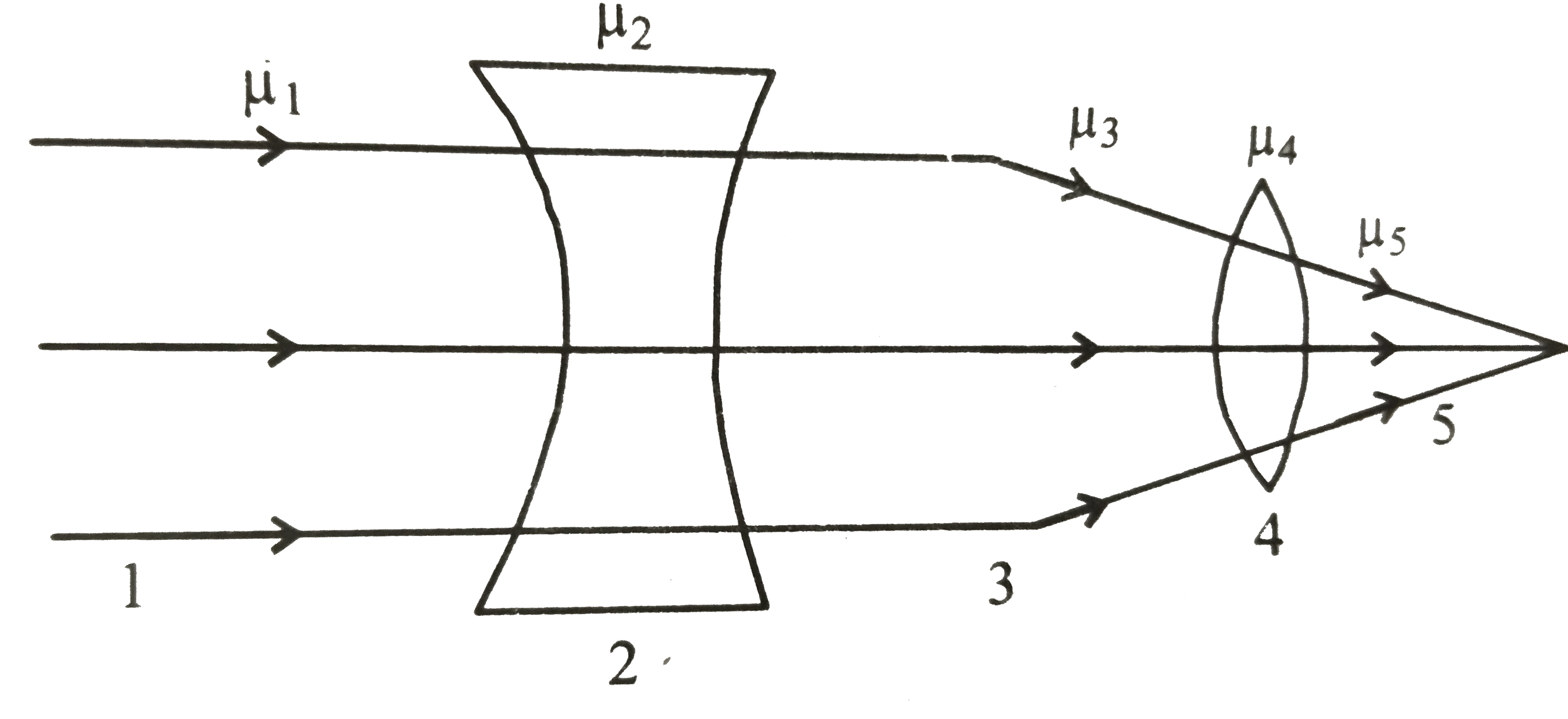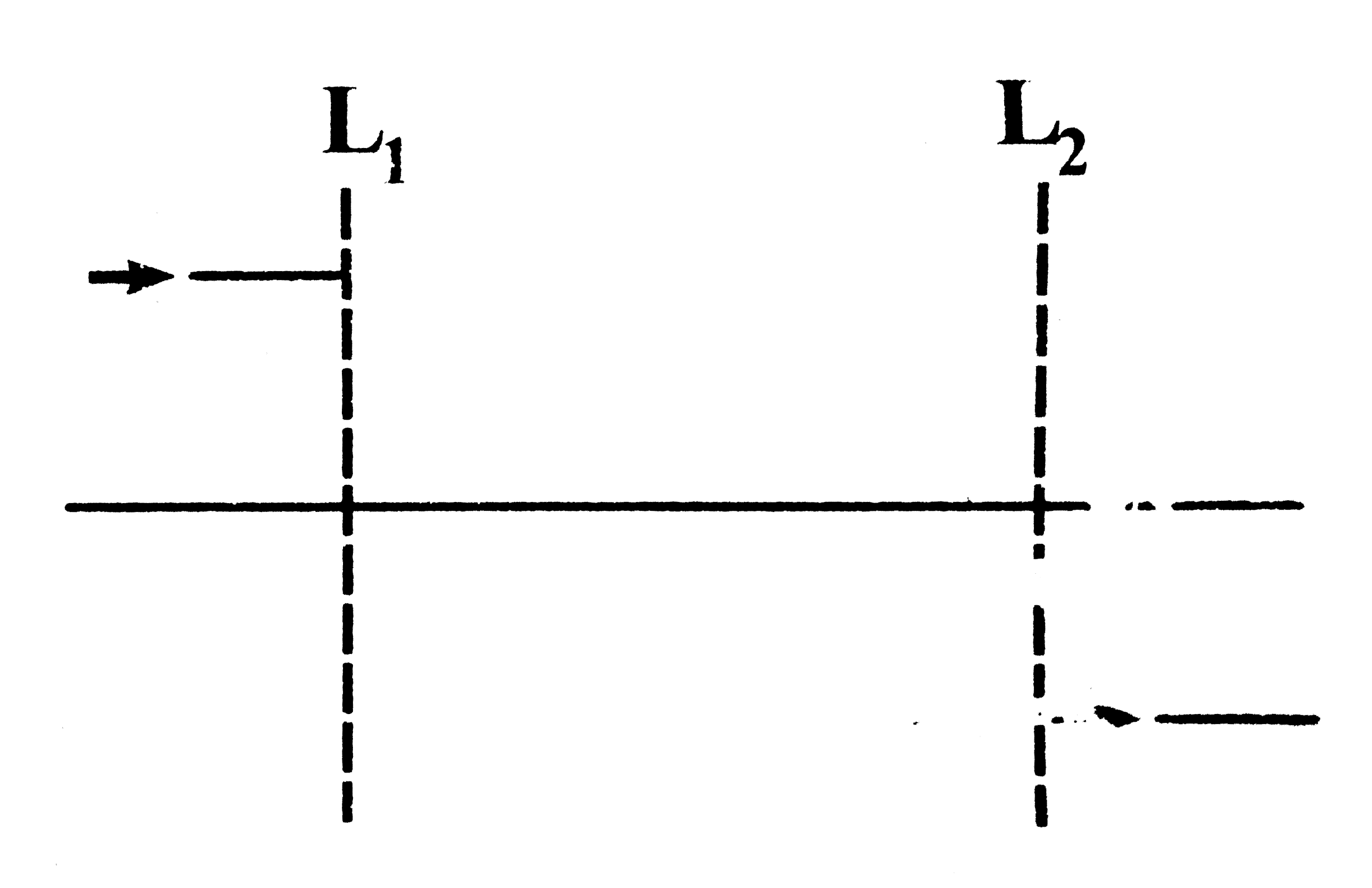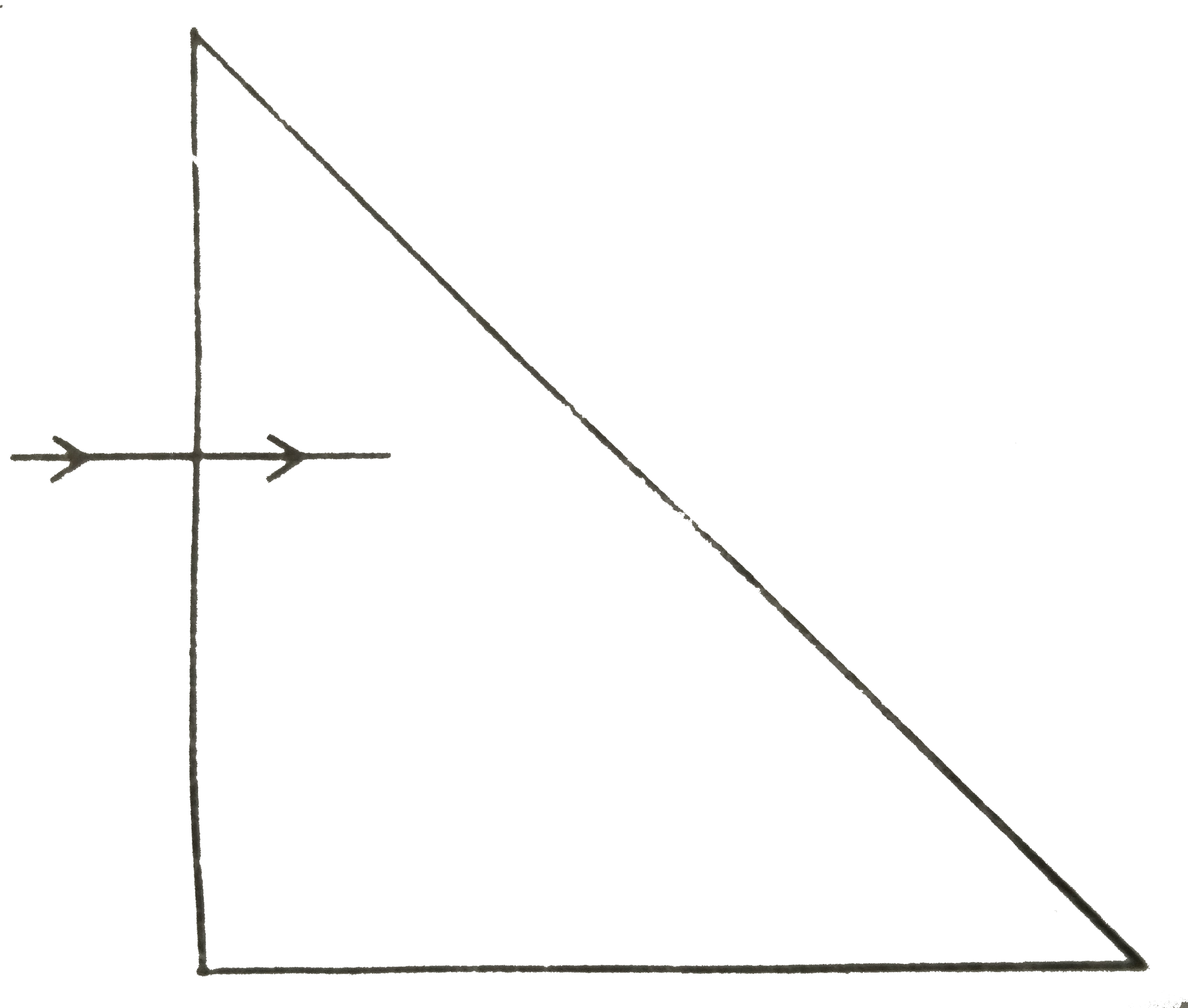Complete Solutions to MCQs of chapter OPTICS of Class 12 book with complete answers and questions
| Class 12 | PHYSICS |
| Chapter | OPTICS |
| NDA PREVIOUS YEAR | MCQs |
| Number Of Questions | 100 |
| Academic Year | 2023-24 |
Two plane mirrors are inclined to each other such that a ray of light incident on the first mirror and parallel to the second is reflected from the second mirror parallel to the first mirror. Determine the angle between the two mirrors:
View Solution
In the figure shown `mu_(1),mu_(2),mu_(3),mu_(4) and mu_(5)` are the refractive
indices of the mediums 1,2,3,4 and 5 respectively. Consider
the following:
(1) `mu_(1)=mu_(2)` (2) `mu_(3)=mu_(4)=mu_(5)`
(3) ` mu_(2) lt mu_(3)` (4) `mu_(4)gt mu_(5)`
Which of the above are correct?
View SolutionWhich one of the following statements is correct?
In an astronomical telescope of regracting type,
View SolutionWhat is the phenomenon of the moon to appear bigger in
size as it approaches the horizon, called ?
View SolutionWhat is the essential difference between a terrestrial
telescope and an astronomical telescope ?
View SolutionA beam of light travelling at a velocity of v m/s is incident at
an angle `45^(@)` on a glass slab of refractive index 1.5. What is
the velocity of the beam of light inside the slab ?
View Solution
In the figure shown above, `L_(1)`and `L_(2)` are two lenses and are
kept along the same axis. A parallel beam of light falling on
`L_(1)` leaves `L_(2)` as a parallel beam:
Consider the following statements.
1. Both `L_(1)` and `L_(2)` can be convex lenses.
2. The distance between the two lenses. can be equal to
sum of their focal lengths.
Which of the statements given above is/are correct ?
View SolutionAstigmatism for a human eye can be removed by using
View SolutionWhen light waves travel frome air to glass, which variables
are affected?
View SolutionWhich on of the following in correct?
Large aperture telescopes are used for
View SolutionConsider the following statements:
1. The focal length of the objective of a microscope is
less than the focal length of the eyepice.
2. The minimum distance between an object and its real
image formed by a convex lens of focal length `f` is eqyal
to `f.`
View SolutionA far-sighted person has a near point at 100 cm. What must
be the power of the correcting lens?
View SolutionIn a simple microscope, the lens is held at a distance d from
the eye and the image is formed at the least distance d of
the distinct vision from the eye. What is the magnifying
Power of the microscope ? Where `f` is the focal length of the lens.
View Solution
A ray of ligh is incident normally on one of the faces of right
angled isosceles prism as shhown above. It undergoes total
internal reflection from hypotenuse. Which on of the
following is the minimum refractive index of the material of
the prism?
View SolutionConsider the following statements:
The principle of total internal reflection is applicable to
explain the
1. Formation of mirage in desert.
2. Formation of image in microscope.
3. Colour of evening sky.
4. Operation of optical fibres.
Which of the statement given above are correct?
View SolutionWhich of the following statements is/are true regarding a
light wave travelling from air to glass?
1. Its frequency remains unchanged.
2. Its speed changes.
Selcet the correct answer using the code given below:
View SolutionWhen an optician prescribes a - 5D lens, what does it mean?
View SolutionIf a substance is behaving as convex lens in air and concave
lens in water then which one of the following is its refractive
index?
View SolutionThe sun is visible a little before the actual sunrise because
of which one of the following?
View SolutionIn vacuum. The speed of light
View SolutionHow far must a girl stand in front of a concave spherical
mirror of radius 120 cm to see an erect image of her face four
times its natural size?
View SolutionAn object is kept 5 cm in front of a concave mirror of focal
length 15 cm. What will be the nature of the image?
View SolutionWhat is the telescope designed to search for earth-size
planets in the nearby region of our galaxy, termed as ?
View SolutionAn object is placed at a distance of 12 cm from a convex lens on its principal axis and a virtual image of certain size is formed. If the object is moved 8 cm away from the lens, a real image of the same size as that of the virtual image is formed. The focal length of the lens in cm is
View SolutionWhen objects at different distances are seen by the eye, which of the following remai constant?
View SolutionThe ratio of the focal length of the obuective to the focal
length of the eyepiece is greater than one for
View SolutionThe radius of curvature of a plane mirror
View SolutionA coin in a beaker filled with water appears raised. This
phenomenon occurs because of the property of
View SolutionA ray of light falls on a transparent glass plate. Part of it is reflected and part is refracted. The reflected and refracted rays can be perpendicular to each other for
View SolutionWhich one of the following is the correct angle between the
incident and reflected rays when a ray of light incident
normally on a plane mirror?
View SolutionWhich one of the following four glass lenses is a diverging
lens?
View SolutionWhich one among the following statements is correct?
View SolutionLight travels in optical fibre irrespective of its shape because
it is a device by which signals can be transferred from one
location to another. It is based on the phenomenon of
View SolutionWhich one among the following is the major cause of
blurring and unsharp images of objects observed through
very large telescopes at the extreme limit of magnofication ?
View SolutionSuppose you are standing 1 m in front of a plane mirror.
What should be the minimum vertical size of the mirror so
that you can see your full image in it ?
View SolutionLight travels slower in glass than in air because
View SolutionA spherical air bubble is embedded in a piece of glass. For a
ray of light passing through the bubble, it behaves like a
View SolutionThe stars seem to be higher on the sky than they actually
are' . This can be explained by
View SolutionWhen a ray of light is going from one medium to another its
View SolutionThe image formed by a convex mirror of a real object is
larger than the object
( u = object distance, `f =` focal length )
View SolutionRefractive index of an optical medium changes with
1. the nature of the medium.
2. the change in the angle of incidence of the ray.
3. colour of the incident ray.
Select the correct answer using the code given below:
View SolutionA one-rupee coin is placed at the bottom of a vessel. Water
is then poured into the vessel such that the depth of water
becomes 20 cm. If water has refractive index 4/3, the coin
would be seen at a depth of
View SolutionWhich one among the following is used to make periscope?
View SolutionWhat is the power of the lens, if the far point of a short-
sighted eye is 200 cm?
View SolutionA refracting telescope consists of
View SolutionIf the focal length of the biconvex lens is 25 cm, then the
power of the lens will be
View SolutionTwo thin convex lenses of focal lengths 4 cm and 8 cm are
separated by a distance of 4 cm in air. The combination will
have the focal length
View SolutionConsider the following statements:
Hypermetropia is a defect of vision in which
1. a person cannot see the distant objects clearly
2. a person cannot see the near objects clearly
3. the near point of the eye gets shifted away from the
normal position
4. the far point of the eye gets shifted towards the eye
Which of the statements given above are correct?
View SolutionTo obtain the powerful parallel beams of light from a
vehicle's headlighl, one must use
View SolutionYellow colour light is used as fog light because yellow colour
View SolutionThe mirror used for the head light of a car is
View SolutionTelescopes are placed in space to view distant galaxies
primarily to
View SolutionThe human eye is like a camera and hence it contains a
system of lens. The eye lens forms
View SolutionAn object is placed at the focus of a concave mirror. The
image will be
View SolutionAn optician prescribes a lens of power =-0.5 dioptre. The
corresponding lens must be a
View SolutionThe following question consist of two statements, one
labelled as the Assertion a and the other as 'Reason (R),
You are to examine these two statements carefully and select
the answer:
Assertion a : A person stands at a distance of 1m in front of
a concave mirror. If the radius of curvature of the mirror is 4 m,
the image of the person lies at a distance 2m behind the mirror.
Reason(R): The general mirror equation congirms the location
of the image from the mirror and it could be a real image.
View SolutionStatement I : A myopic person is advised to use concave lens.
Statement II : The eye lens of a myopic person focuses the
parallel rays coming from distant ogject in from distant objects in front of the retina.
View SolutionStatement I : Convex mirror is used as a driver mirror.
Statement II : Images formed by convex mirror are
diminished in size.
View SolutionA beautiful rainbow on the sky is due to the
View SolutionDuring sunrise and sunset, sun appears reddish-orange
because
View SolutionRays of light get refracted while passing from air to glass
because
View SolutionWhite light while passing through a glass prism breaks up
into light of different colocurs because
View SolutionConsider the following statements:
A real image
1. can be formed on a screen
2. is always magnified and inverted
Which of the statements given above is/are correct?
View SolutionIf speed of light in air is `3xx10^(8) m//s,` the speed of light in
glass (with refractive index 1.5) would be
View SolutionWhile looking at an image formed by a convex lens (one half
of the lens is covered with a black paper), which one of the
following will happen to the image?
View SolutionIn optical instruments, the lenses are used to form image by
the phenomenon of
View SolutionA ray of light travels from a medium of refractive index `n_(1)` to
a medium of refractive index `n_(2)`. If angle of incidence is i and
angle of refraction is r, than `(sin i)/(sin r)` is equal to
View SolutionLight waves projected on oil surface show seven colours
due to the phenomenon of
View SolutionWhich one of the following processes explains the splitting
of a beam of white light into its constituent colours?
View SolutionOptical glass used in the construction of spectacles is made
by
View SolutionLight waves are
View SolutionStatement I : Diamond is very bright.
Statement II : Diamond has verylow refactive index.
View SolutionStatement I : Due to diffused of irregular reflection of light,
a closed room gets light even if no direct sunlight falls falls inside
the room. Statement II : Irregular reflection, where the reflected rays
are not parallel, does not follow the laws of reflection.
View SolutionOptical fibres, though bent in any manner, allows light to pass
through. What is the inference that one can draw from it?
View SolutionA ray of light when refracted suffers change in velocity. In
this context, which one among the following statements is
correct ?
View SolutionAn object placed 10 cm in front of a convex lens of focal
length 15 cm. The image produced will be
View SolutionIn case of a compound microscope which of the following
Statements is/are correct ?
1. The focal length of the eye piece is larger than the
focal length of the objective
2. The focal length of the eye piece is smaller than the focal length of the objective
3. The image produced in a normal optical microscope is
real
4. The image produced in a normal optical microscope is
virtual
Select the correct answer using the code given below:
View SolutionWhich one of the following statements is not correct ?
View SolutionWhich one of the following statements is correct?
View SolutionAn object is placed at the centre of curvature of a concave
mirror of focal length 16 cm. If the object iis shifted by 8 cm
towards the focus, the nature of the image would be
View SolutionAn object is placed at a distance of `10 cm` from a convex mirror of focal length `15 cm`. Find the position and nature of the image ?
View SolutionA lady is standing in front of a plane mirror at a distance of
1 m from it. She walks 60 cm towards the mirror. The distance
of her image now from herself (ignoring the thickness of the
mirror) is
View SolutionThe brightness of a star depends on its
View SolutionAn optica illusion which occurs mainly in deserts during ltbgt hot summer is based on the principle of
View SolutionMatch List I with List II and select the correct answer using
the code given below the Lists :
`{:(" Lists I Lists II"),(" (Disease) (Remedy)"),("A. Hypermetropia 1. Concave lens"),("B. Presbyopia 2. Bifocal lens"),("C. Myopia 3. Surgery"),("D. Cataract 4. Convex lens"):}`
Code
A B C D
View SolutionWhich one of the following statements is correct about the
magnification of an optical microscope?
View SolutionThe radii of curvature of the faces of a double convex lens
are 10 cm and 20. The refractive index of the glass is 1.5.
What is the power of this lens (in units of dioptre)?
View SolutionAbsolute refractive indices of glass and water are `3//2` and `4//3`. The ratio of velocity of light in glass and water will be
View SolutionThe mirrors used as rear-view mirrors in vehicles are
View SolutionConcave mirror is used in headlights of vehicles, because
it
View SolutionWhich one of the following is the natural phenomenon
based on which a simple periscope works?
View SolutionWhich one of the following statements about the refractive
index of a material medium with respect to air is correct?
View SolutionTwo convex lenses with power 2 dioptre are kept in contact
with each other. The focal length of the combined lens
system is
View SolutionConsider the following statements about a microscope and a
telescope
1. Both the eyepiece and the objective of a microscope
are convex lenses.
2. The focal length of the objective of a telescope is
lerger than the focal length of its eyepiece.
3. The magnification of a telescope increases with the
increases in focal length of its objective.
4. The magnification of a microscope increases with the
increases in focal length of its objective.
Which of the statements given above are correct?
View SolutionIf the focal length of a convex lens is 50 cm, which one of the
following is its power?
View SolutionThe refractive indices of two media, are denoted by `n_(1)` and
`n_(2)` and the velocities of light in these two media are
respectively `v_(1) and v_(2). If n_(2)//n_(1)` is 1.5, which one of the following statements is correct?
View SolutionWhich one of the following statements is correct for a plane
mirror?
View SolutionAn object is placed in front of a convex mirror. Which one
of the following statements is correct?
View SolutionThe light energy escaping from the Sun can be spread by
View SolutionThe focal length of the objective lens of a telescope is 50
cm If the magnification of the telescope is 25, then the
focal length of the eye-piece is
View Solution
MCQs questions and complete solutions for chapter OPTICS of NDA PREVIOUS YEARS of Class 12